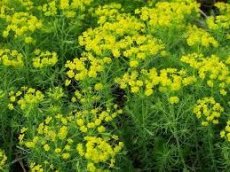New publications
Milkweed can help clean up oil slicks.
Last reviewed: 02.07.2025

All iLive content is medically reviewed or fact checked to ensure as much factual accuracy as possible.
We have strict sourcing guidelines and only link to reputable media sites, academic research institutions and, whenever possible, medically peer reviewed studies. Note that the numbers in parentheses ([1], [2], etc.) are clickable links to these studies.
If you feel that any of our content is inaccurate, out-of-date, or otherwise questionable, please select it and press Ctrl + Enter.

Milkweed, a weed that most farmers try to get rid of, has been widely grown in Quebec, Canada. The plant is used to produce materials that help clean up oil spills, both on land and in water.
Plants belonging to the Euphorbiaceae family (small trees, shrubs, herbs) contain fibers that are unique in their natural qualities. The fibers have good hydrophobicity (repel water) and are capable of absorbing several times more oil, compared to polypropylene materials, which are now used to clean oil spills.
The light and hollow fibres are easily carried by the wind, allowing the plant to propagate over fairly large distances.
As François Simard, director of the company that produces absorbent materials, noted, the milkweed fibres remain dry and light due to the wax coating. Such qualities are extremely rare in the natural environment.
To create a unique absorbent material, specialists mechanically remove the fibers from the milkweed seed and pods, which are then filled into pipes. Then all the pipes are assembled into specific sets and placed on top of the oil-contaminated surface.
According to the manufacturer, no chemicals are used in the process. As tests have shown, 155 g of milkweed fibers are capable of absorbing seven liters of oily liquid at a rate of 23 l/min, which is twice as fast as the polypropylene materials currently used.
A ready-made kit with milkweed fibers is capable of absorbing about 200 liters of oil, after which such a kit should be removed from the contaminated surface.
Similar kits are already being supplied to Parks Canada (a Canadian government agency) for use in oil spill areas if needed.
There are currently 20 farms that produce milkweed. There are plans to open 35 more farms in the future. Milkweed is grown on the farms without any fertilizers or additional irrigation, and all the farms are located in the plant's natural regions.
Simard noted that growing milkweed is quite efficient, as 125 sets can be produced per hectare, which in total are capable of collecting approximately 25 thousand liters of oil.
It is worth noting that milkweed farms contribute to the reproduction of monarch butterflies, which live in southern Canada during the summer. The insects lay their offspring on milkweed, as this plant is the main food source for the caterpillars.
In recent years, the number of these butterflies has decreased significantly, since various pesticides are actively used in agriculture. The country even has a special program in which milkweed should be planted along the migration route of these butterflies. For this reason, growing milkweed is necessary to maintain the population of these majestic butterflies.
The manufacturing company does not intend to stop at growing milkweed only for the production of oil-absorbing kits. The company plans to produce insulation material for winter clothing. According to experts, jackets with milkweed fibers will be better and warmer than models with goose down.
 [ 1 ]
[ 1 ]
